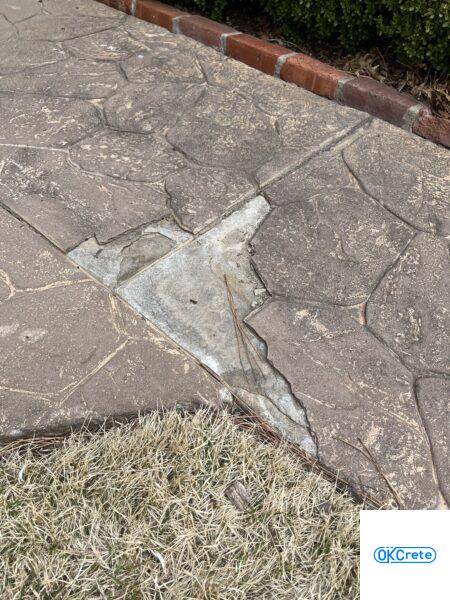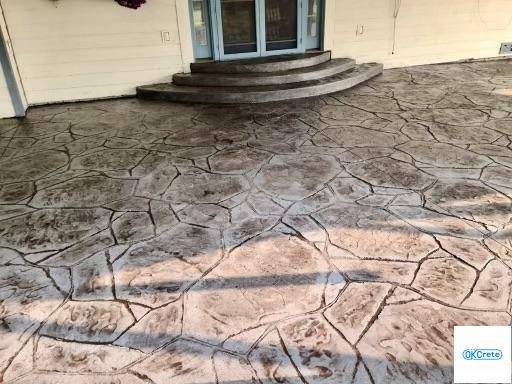Concrete overlays have become increasingly popular in recent years as a budget-friendly way to update and enhance existing concrete surfaces. These overlays are essentially a new, thin layer of concrete that is applied over an existing concrete surface.
While they may seem like a great budget solution at first glance, there are several downsides to using concrete overlays that are often overlooked.
Let’s explore the downsides of concrete overlays and why they may not be the best choice for your next project.
What are Concrete Overlays?
This process is typically used to update or enhance the look of old or damaged concrete surfaces. Concrete overlays can be used on a variety of surfaces, including driveways, patios, and walkways.
How do Concrete Overlays Work?
Concrete overlays work by applying a thin layer of concrete over an existing concrete surface. The existing surface is first cleaned and prepared, and then a bonding agent is applied to ensure that the overlay adheres properly.
Once the bonding agent has dried, the concrete overlay is applied. The overlay can be colored or stamped to create a variety of designs and patterns.
Benefits of Concrete Overlays
One of the main benefits of concrete overlays is that they are a cost-effective solution for updating and enhancing existing concrete surfaces.
They are also quick to install, which means that you can have a new, updated surface in a short amount of time.
Additionally, concrete overlays can be customized to suit your specific design preferences, which means that you can create a unique look for your home or business.
Drawbacks of Concrete Overlays
While there are some benefits to using concrete overlays, there are also several drawbacks that are often overlooked. One of the main drawbacks is that concrete overlays are not as durable as traditional concrete surfaces.

As they’re thinner concrete, the overlay may be more likely to crack or chip, especially under any weight. This means more costly repairs than if you would have initially replaced the deteriorated concrete underneath, never needing any overlay to begin with.
Additionally, concrete overlays may not hold up as well in extreme weather conditions, which means that they may not be the best choice for areas that experience frequent freeze-thaw cycles.
Another drawback of concrete overlays is that they have limited design options. While they can be customized to a certain extent, they are not as versatile as traditional concrete surfaces. This means that if you are looking for a unique design, you may be limited in your options.
Additionally, concrete overlays may not be the best choice for areas with heavy foot or vehicle traffic, as they may not hold up as well over time.
Cost of Concrete Overlays
The cost of concrete overlays can vary depending on a number of factors, including the size of the area that needs to be covered, the type of overlay being used, and the complexity of the design.
In general, concrete overlays are less expensive than traditional concrete surfaces, but they may not be the most cost-effective option in the long run. This is because the durability of the overlay may not be as high as traditional concrete, which means that you may need to invest more in repairs and maintenance over time.
Maintenance Issues with Concrete Overlays
Another drawback of concrete overlays is that they require regular maintenance to ensure that they stay in good condition. This can include regular cleaning and sealing to prevent damage from moisture and other elements.
Plus, if the overlay does crack or chip, it may need to be repaired to prevent further damage. These maintenance requirements can add to the overall lifetime cost of using concrete overlays, which is why they aren’t considered the best investment in the long run.
Alternatives to Concrete Overlays
If you are looking for an alternative to concrete overlays, there are several options to consider. One option is to use traditional concrete surfaces, which are more durable and have a wider range of design options.
Sometimes people choose an overlay design they wouldn’t have otherwise picked. Replacing concrete allows you to ensure a strong base that should last many years, plus you can style it however you want, especially with decorative concrete options like stamped concrete or integral color.

Another option is to use pavers or other types of interlocking stones, which can provide a unique look and are more durable than concrete overlays. Additionally, if you are looking for a more eco-friendly option that doesn’t need to support much weight, you could consider using permeable paving, which allows water to seep through to the ground below.
At OKCrete Oklahoma Concrete, we DO offer decorative concrete, whether as an initial install or replacing old concrete. However, we do not offer several of the other services mentioned in this article like concrete overlay, pavers, or permeable paving. We strongly recommend permanent solutions, unlike concrete overlays.
When you contact us, we listen to your ideas and inform you of your options. We’re happy to discuss your goals and advise how we may (or may not) be of service toward making your yard just how you want it.
Conclusion: Is a Concrete Overlay Worth the Investment?
While concrete overlays may initially seem like a great solution for updating and enhancing existing concrete surfaces, there are several downsides to consider.
From poor durability to limited design options, these overlays may not be worth the investment in the long run. If you are looking for a cost-effective solution, traditional concrete surfaces may be a better option.
Ultimately, the decision will depend on your specific needs and preferences. By understanding the potential drawbacks of concrete overlays, you can make an informed decision and ensure that your investment yields the best possible results.
